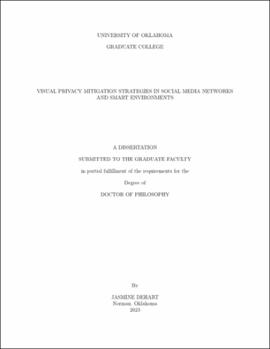| dc.description.abstract | The contemporary use of technologies and environments has led to a vast collection and sharing of visual data, such as images and videos. However, the increasing popularity and advancements in social media platforms and smart environments have posed a significant challenge in protecting the privacy of individuals’ visual data, necessitating a better understanding of the visual privacy implications in these environments. These concerns can arise intentionally or unintentionally from the individual, other entities in the environment, or a company. To address these challenges, it is necessary to inform the design of the data collection process and deployment of the system by understanding the visual privacy implications of these environments. However, ensuring visual privacy in social media networks and smart environments presents significant research challenges. These challenges include accounting for an individual’s subjectivity towards visual privacy, the influence of visual privacy leakage in the environment, and the environment’s infrastructure design and ownership. This dissertation employs a range of methodologies, including user studies, machine learning, and statistics to explore social media networks and smart environments and their visual privacy risks. Qualitative and quantitative studies were conducted to understand privacy perspectives in social media networks and smart city environments.
The findings reveal that individuals and stakeholders possess inherited bias and subjectivity when considering privacy in these environments, leading to a need for visual privacy mitigation and risk analysis. Furthermore, a new visual privacy risk score using visual features and computer vision is developed to investigate and discover visual privacy leakage. However, using computer vision methods for visual privacy mitigation introduces additional privacy and fairness risks while developing and deploying visual privacy systems and machine learning algorithms. This necessitates the creation of interactive audit strategies to consider the broader impacts of research on the community. Overall, this dissertation contributes to advancing visual privacy solutions in social media networks and smart environments by investigating xiii and quantifying the visual privacy concerns and perspectives of individuals and stakeholders, advocating for the need for responsible visual privacy mitigation methods in these environments. It also strengthens the ability of researchers, stakeholders, and companies to protect individuals from visual privacy risks throughout the machine learning pipeline. | en_US |

